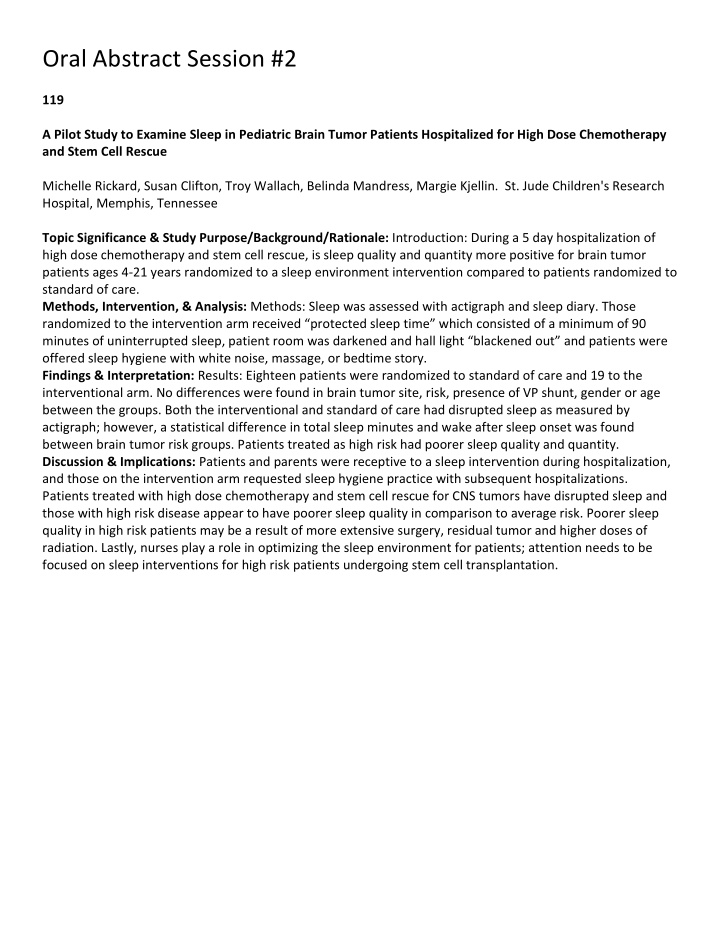



Oral ¡Abstract ¡Session ¡#2 ¡ ¡ 119 ¡ ¡ A ¡Pilot ¡Study ¡to ¡Examine ¡Sleep ¡in ¡Pediatric ¡Brain ¡Tumor ¡Patients ¡Hospitalized ¡for ¡High ¡Dose ¡Chemotherapy ¡ and ¡Stem ¡Cell ¡Rescue ¡ ¡ Michelle ¡Rickard, ¡Susan ¡Clifton, ¡Troy ¡Wallach, ¡Belinda ¡Mandress, ¡Margie ¡Kjellin. ¡ ¡St. ¡Jude ¡Children's ¡Research ¡ Hospital, ¡Memphis, ¡Tennessee ¡ ¡ Topic ¡Significance ¡& ¡Study ¡Purpose/Background/Rationale: ¡Introduction: ¡During ¡a ¡5 ¡day ¡hospitalization ¡of ¡ high ¡dose ¡chemotherapy ¡and ¡stem ¡cell ¡rescue, ¡is ¡sleep ¡quality ¡and ¡quantity ¡more ¡positive ¡for ¡brain ¡tumor ¡ patients ¡ages ¡4-‑21 ¡years ¡randomized ¡to ¡a ¡sleep ¡environment ¡intervention ¡compared ¡to ¡patients ¡randomized ¡to ¡ standard ¡of ¡care. ¡ Methods, ¡Intervention, ¡& ¡Analysis: ¡Methods: ¡Sleep ¡was ¡assessed ¡with ¡actigraph ¡and ¡sleep ¡diary. ¡Those ¡ randomized ¡to ¡the ¡intervention ¡arm ¡received ¡“protected ¡sleep ¡time” ¡which ¡consisted ¡of ¡a ¡minimum ¡of ¡90 ¡ minutes ¡of ¡uninterrupted ¡sleep, ¡patient ¡room ¡was ¡darkened ¡and ¡hall ¡light ¡“blackened ¡out” ¡and ¡patients ¡were ¡ offered ¡sleep ¡hygiene ¡with ¡white ¡noise, ¡massage, ¡or ¡bedtime ¡story. ¡ Findings ¡& ¡Interpretation: ¡Results: ¡Eighteen ¡patients ¡were ¡randomized ¡to ¡standard ¡of ¡care ¡and ¡19 ¡to ¡the ¡ interventional ¡arm. ¡No ¡differences ¡were ¡found ¡in ¡brain ¡tumor ¡site, ¡risk, ¡presence ¡of ¡VP ¡shunt, ¡gender ¡or ¡age ¡ between ¡the ¡groups. ¡Both ¡the ¡interventional ¡and ¡standard ¡of ¡care ¡had ¡disrupted ¡sleep ¡as ¡measured ¡by ¡ actigraph; ¡however, ¡a ¡statistical ¡difference ¡in ¡total ¡sleep ¡minutes ¡and ¡wake ¡after ¡sleep ¡onset ¡was ¡found ¡ between ¡brain ¡tumor ¡risk ¡groups. ¡Patients ¡treated ¡as ¡high ¡risk ¡had ¡poorer ¡sleep ¡quality ¡and ¡quantity. ¡ ¡ Discussion ¡& ¡Implications: ¡Patients ¡and ¡parents ¡were ¡receptive ¡to ¡a ¡sleep ¡intervention ¡during ¡hospitalization, ¡ and ¡those ¡on ¡the ¡intervention ¡arm ¡requested ¡sleep ¡hygiene ¡practice ¡with ¡subsequent ¡hospitalizations. ¡ Patients ¡treated ¡with ¡high ¡dose ¡chemotherapy ¡and ¡stem ¡cell ¡rescue ¡for ¡CNS ¡tumors ¡have ¡disrupted ¡sleep ¡and ¡ those ¡with ¡high ¡risk ¡disease ¡appear ¡to ¡have ¡poorer ¡sleep ¡quality ¡in ¡comparison ¡to ¡average ¡risk. ¡Poorer ¡sleep ¡ quality ¡in ¡high ¡risk ¡patients ¡may ¡be ¡a ¡result ¡of ¡more ¡extensive ¡surgery, ¡residual ¡tumor ¡and ¡higher ¡doses ¡of ¡ radiation. ¡Lastly, ¡nurses ¡play ¡a ¡role ¡in ¡optimizing ¡the ¡sleep ¡environment ¡for ¡patients; ¡attention ¡needs ¡to ¡be ¡ focused ¡on ¡sleep ¡interventions ¡for ¡high ¡risk ¡patients ¡undergoing ¡stem ¡cell ¡transplantation. ¡ ¡ ¡ ¡
Oral ¡Abstract ¡Session ¡#2 ¡ ¡ 120 ¡ ¡ Hear ¡Our ¡Voices: ¡Patient's ¡Perspective ¡of ¡Financial ¡Impact ¡of ¡Allogeneic ¡HCT ¡ ¡ Mary ¡Weise, ¡Dr. ¡Nandita ¡Khera, ¡Dr ¡Pierre ¡Noel. ¡ ¡Mayo ¡Clinic ¡Arizona, ¡Phoenix, ¡Arizona ¡ ¡ Topic ¡Significance ¡& ¡Study ¡Purpose/Background/Rationale: ¡Medical ¡science ¡has ¡made ¡great ¡improvement ¡in ¡ Allogeneic ¡Hematopoietic ¡Cell ¡Transplantation ¡(HCT) ¡over ¡recent ¡decades. ¡ ¡Current ¡treatment ¡modalities ¡offer ¡ many ¡recipients ¡curative ¡treatment ¡or ¡increased ¡long-‑term ¡survivorship. ¡ ¡ ¡Practice ¡guidelines ¡are ¡working ¡to ¡ identify ¡and ¡improve ¡patient ¡care ¡outcomes ¡and ¡long-‑term ¡effects ¡of ¡HCT, ¡offering ¡patients ¡an ¡opportunity ¡to ¡ live ¡with ¡their ¡disease ¡post-‑transplant. ¡ ¡However, ¡the ¡reality ¡is ¡that, ¡for ¡many, ¡surviving ¡HCT ¡offers ¡a ¡mixed ¡ blessing. ¡ ¡Many ¡practitioners ¡have ¡identified ¡frustrations ¡in ¡post-‑transplant ¡follow-‑up ¡care ¡related ¡to ¡the ¡ financial ¡impact ¡of ¡HCT ¡care. ¡ ¡Patients ¡report ¡devastating ¡impacts ¡upon ¡quality ¡of ¡life ¡(QOL), ¡beyond ¡the ¡ medical ¡concerns ¡of ¡GVHD ¡or ¡other ¡chronic ¡health ¡problems ¡related ¡to ¡HCT. ¡ ¡They ¡report ¡life ¡stressors ¡which ¡ may ¡ultimately ¡affect ¡their ¡health ¡and ¡well-‑being. ¡ ¡While ¡much ¡has ¡been ¡done ¡to ¡offer ¡improved ¡survivorship ¡ and ¡quality ¡of ¡care ¡with ¡HCT, ¡little ¡seems ¡to ¡have ¡been ¡studied ¡regarding ¡the ¡QOL ¡and ¡financial ¡impact ¡of ¡HCT ¡ upon ¡post-‑transplant ¡survivors. ¡ ¡ Methods, ¡Intervention, ¡& ¡Analysis: ¡Data ¡analysis ¡included ¡qualitative ¡analysis ¡based ¡on ¡a ¡questionnaire ¡which ¡ was ¡mailed ¡to ¡482 ¡patients ¡(268 ¡respondents= ¡56%) ¡who ¡had ¡survived ¡allogeneic ¡HCT ¡at ¡the ¡3 ¡study ¡sites ¡at ¡ Mayo ¡Clinic ¡from ¡1/06 ¡to ¡6/12. ¡ ¡Questions ¡in ¡the ¡survey ¡were ¡about ¡health ¡insurance, ¡prescription/medical ¡ costs, ¡and ¡employment ¡which ¡allowed ¡for ¡subjective ¡data ¡on ¡illness ¡and ¡the ¡impact ¡that ¡HCT ¡has ¡on ¡one’s ¡ QOL, ¡physical ¡and ¡emotional ¡well-‑being, ¡personal ¡finances, ¡as ¡well ¡as ¡resource ¡allocation ¡post-‑HCT. ¡ ¡ ¡A ¡section ¡ in ¡the ¡questionnaire ¡allowed ¡for ¡patient ¡comments. ¡ ¡This ¡study ¡discusses ¡their ¡open-‑ended, ¡candid ¡responses ¡ to ¡the ¡impact ¡of ¡transplant. ¡ ¡It ¡also ¡allowed ¡for ¡any ¡thoughts ¡in ¡information ¡that ¡could ¡have ¡helped ¡them ¡ better ¡prepare ¡financially ¡for ¡post-‑transplant ¡care. ¡ ¡ ¡ Findings ¡& ¡Interpretation: ¡Our ¡sample ¡(n=268 ¡respondents) ¡reported ¡issues ¡with ¡employment, ¡insurance, ¡and ¡ disability. ¡ ¡A ¡majority ¡conveyed ¡an ¡adverse ¡financial ¡impact ¡(>54%) ¡such ¡as ¡a ¡reduction ¡in ¡household ¡income ¡ >50%, ¡need ¡to ¡sell/mortgage ¡home, ¡withdraw ¡money ¡from ¡savings, ¡and ¡paying ¡more ¡than ¡they ¡could ¡afford ¡ for ¡their ¡medical ¡care. ¡73% ¡reported ¡that ¡being ¡sick ¡had ¡hurt ¡them ¡financially, ¡with ¡3% ¡declaring ¡bankruptcy. ¡ ¡ Conclusions: ¡ ¡A ¡significant ¡proportion ¡of ¡post-‑HCT ¡survivors ¡report ¡an ¡impact ¡on ¡their ¡personal ¡finances ¡and ¡ QOL, ¡despite ¡having ¡health ¡insurance ¡coverage. ¡ ¡Future ¡research ¡could ¡help ¡identify ¡at-‑risk ¡patients, ¡counsel ¡ resources, ¡and ¡support ¡interventions ¡which ¡could ¡improve ¡outcomes ¡of ¡HCT. ¡ ¡ Discussion ¡& ¡Implications: ¡As ¡transplant ¡practitioners, ¡we ¡are ¡trying ¡to ¡be ¡advocates ¡of ¡cancer ¡survivorship, ¡ yet ¡consideration ¡of ¡QOL ¡and ¡the ¡financial ¡impact ¡of ¡transplant ¡care ¡should ¡be ¡considered ¡if ¡we ¡are ¡to ¡practice ¡ ethically. ¡ ¡Recommendations ¡for ¡correlating ¡QOL ¡studies ¡in ¡HCT, ¡can ¡help ¡to ¡improve ¡patient ¡outcomes ¡ throughout ¡the ¡continuum ¡of ¡care, ¡while ¡helping ¡our ¡patients ¡in ¡what ¡can ¡be ¡lifelong ¡coping ¡with ¡chronic ¡ survivorship. ¡ ¡Open-‑ended ¡patient ¡responses ¡help ¡give ¡practioners ¡a ¡sense ¡of ¡the ¡emotion ¡and ¡depth ¡of ¡impact ¡ as ¡they ¡tell ¡us ¡how ¡transplant ¡affected ¡their ¡lives. ¡ ¡It ¡is ¡important ¡to ¡let ¡patient's ¡know ¡we ¡are ¡listening, ¡so ¡that ¡ we ¡can ¡open ¡paths ¡for ¡conversation ¡and ¡improve ¡outcomes. ¡ ¡ ¡
Recommend
More recommend